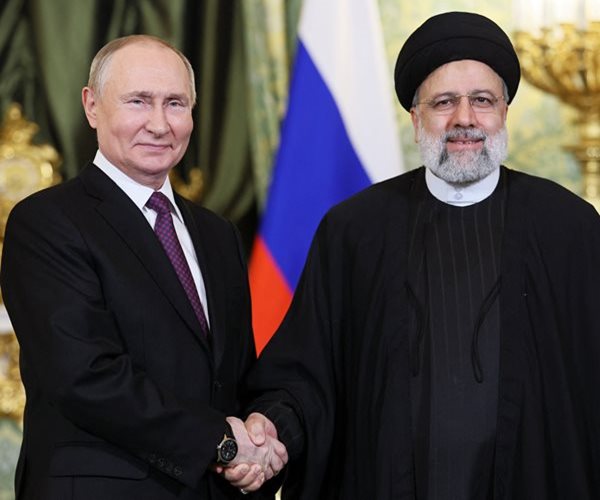[ad_1]
The U.S. will bear long-term economic costs for failing to adequately confront Russian- and Iranian-sponsored aggression. These emerging stalemates will siphon money and other resources that could be better devoted to U.S. growth and prosperity.
Additional U.S. aid to Ukraine could help matters but even if Congress approves this, U.S. and German policies of withholding long-range missiles and other armaments necessary for Ukraine to break Russian supply lines destines Ukraine to a slow grinding war of attrition and a likely stalemate.
Meanwhile, Russia has overcome economic sanctions. After shrinking 2.7% in 2022, its economy grew 3.6% in 2023 and 2.6% growth is projected for this year. Russia devotes 6% of GDP to its military.
Message to Europe
Holding U.S. aid to Ukraine hostage to immigration reform sends a clear message to Europe that it can no longer rely on America. German Defense Minister Boris Pistorius estimates that Germany will have to boost military spending to 3.5% of GDP from the NATO target of 2%. A similar calculus applies to most of Europe.
Europe is already challenged by the loss of inexpensive natural gas from Russia and the transition to a more carbon-free economy. Germany faces tough competition from China in electric vehicle and batteries industries.
Economic sanctions on Russia are adversely affecting the EU even more. Shortly before Russia’s invasion of Ukraine in February 2022, the EU Commission projected GDP growth for the EU at 4.3% and 2.5% for 2022 and 2023. Actual growth for 2022 and 2023 was 3.5% and 0.5%, respectively, and it is unlikely to exceed 1% this year.
Devoting another 1.5% of GDP to discourage Russian President Vladimir Putin’s revanchist agenda would shrink Europe’s civilian economies further and make the investments to compete with Chinese manufacturing and American technology exponentially more difficult.
Iran’s Actions
Iran is financing Hamas in Gaza, Hezbollah in Lebanon and Syria, and Houthis in Yemen. Neutralizing Iran’s destabilizing activities will require more than accomplishing a difficult to obtain two-state solution for Israel and the Palestinians.
Terrorist attacks on shipping are forcing a de facto partial closure of the Suez Canal and increasing freight costs globally by tying up container ships for longer voyages. Piracy is rising off the coast of Somalia, the Gulf of Aden, and in the Strait of Malacca.
U.S. attacks on terrorist sites do not address the fundamental problem. Failing to confront Iran and piracy elsewhere likely makes ending shipping risks as difficult as resolving the Palestinian-Israeli problem.
More than half of all seaborne commerce passes through the above-mentioned choke points. Without a solution to terrorism and piracy, elevated costs in global commerce are becoming permanent.
Divided Trade
However necessary, U.S. decoupling from China — other things remaining as before the crises in Ukraine and Gaza — could reduce U.S. GDP by at least 2% to 3%. But Americans are not facing the status quo.
WTO and IMF research indicates the emerging division of the global economy into U.S.-led and Chinese-centered trade blocs will reduce global GDP by 5% to 7%. Add the more recent disruptions to seaborne trade, and the cost to U.S. and global GDP becomes much greater.
To protect Israel from a widening war, the U.S. is now stationing two aircraft carrier groups and other naval assets nearby. The U.S. Navy has about 300 ships and at any time, only about one-third are deployed.
Failing to enable the Ukrainians to defeat Russia ties down the Europeans— the U.S. can expect little help from them in Asia. Failing to deal decisively with Iran occupies a significant portion of the U.S. Navy that could be better deployed to secure commerce in the Pacific.
Even before Gaza, the U.S. needed a larger fleet to address the threat China poses in the Pacific. Losing Taiwan and its semiconductor fabs could set back U.S and global GDP by 5% and 10%.
If the United States does not deal directly with Iran — yet remains committed to protecting Israel and combating piracy in the Middle East —the U.S. Navy will need an even larger fleet given the growth of the Chinese navy.
Bigger defense budgets would crowd out investments and growth in the civilian economy, just as the U.S. is on the precipice of accelerated growth. Goldman Sachs estimates AI could lift annual economic growth by 1.5 percentage points over a 10-year period.
If Americans don’t see those gains in living standards, it will be due in no small measure to the decoupling from China, compounded by Washington’s failure to deal decisively with Russia and Iran.
_______________
Peter Morici is an economist and emeritus business professor at the University of Maryland, and a national columnist
© 2024 Newsmax Finance. All rights reserved.
